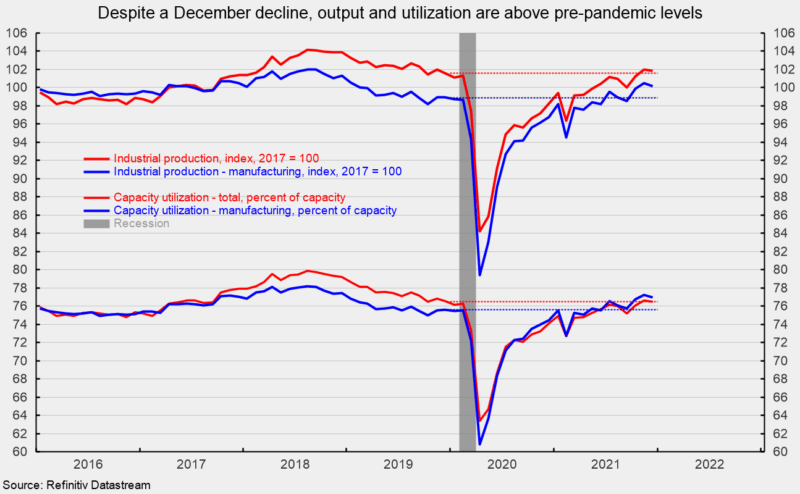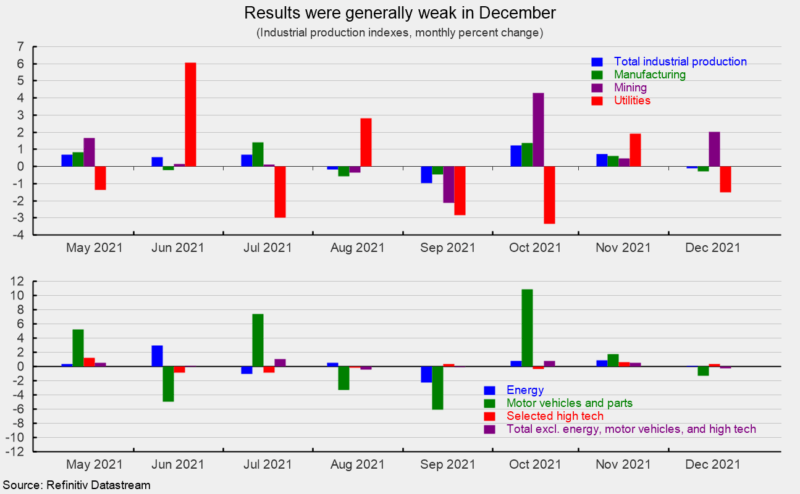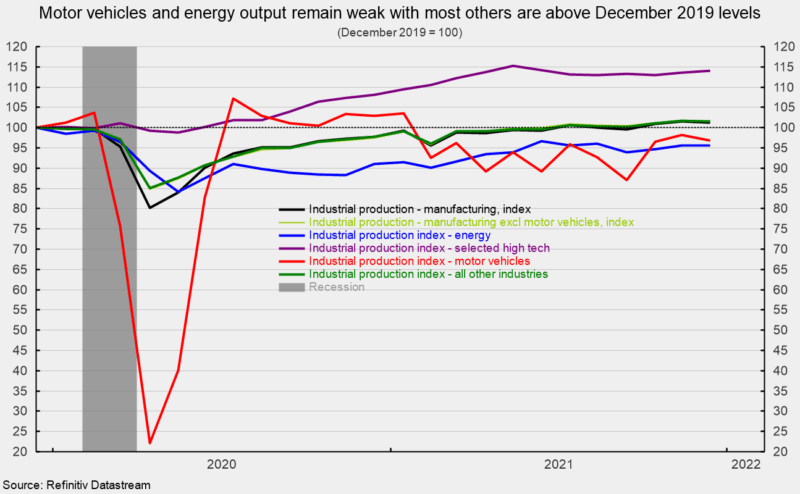Manufacturing Output Fell Slightly in December
Industrial production fell 0.1 percent in December following strong gains in October and November. Despite the small setback, output remains slightly above the December 2019 level (see first chart). Over the past year, total industrial output is still up 3.7 percent.
Capacity utilization decreased 0.1 points to 76.5 percent from 75.6 percent in November, matching the December 2019 level (see first chart). Total capacity utilization remains well below the long-term (1972 through 2020) average of 79.6 percent.
Manufacturing output – about 76 percent of total output – posted a 0.3 percent decrease for the month, following back-to-back gains in October and November (see first chart). Manufacturing output is 1.3 percent above its December 2019 level (see first chart) and is up 3.5 percent from a year ago.
Manufacturing utilization fell 0.2 points to 77.0 percent, above the December 2019 level of 75.6 percent (see first chart). However, manufacturing utilization remains below its long-term average of 78.2 percent and well below the 1994-95 high of 84.7 percent.
Mining output accounts for about 12 percent of total industrial output and posted a robust 2.0 percent increase last month (see top of second chart). Over the last 12 months, mining output is up 11.0 percent.
Utility output, which is typically related to weather patterns and is also about 12 percent of total industrial output, decreased 1.5 percent for the month (see top of second chart). From a year ago, utility output is down 3.4 percent.
Among the key segments of industrial output, energy production (about 25 percent of total output) rose 0.1 percent for the month (see bottom of second chart) with mixed results among the five components. Total energy production is up 5.0 percent from a year ago but is about 4.5 percent below the December 2019 level (see third chart).
Motor-vehicle and parts production (about 5 percent of total output), one of the hardest-hit industries during the lockdowns, continues to be volatile as the industry struggles with a semiconductor chip shortage. Motor-vehicle and parts production fell 1.3 percent in December following a 1.7 percent rise in November and a 10.8 percent jump in October (see bottom of second chart). From a year ago, vehicle and parts production is still off 5.9 percent, and compared to December 2019, output is off 3.1 percent (see third chart). Total vehicle assemblies fell to 9.28 million at a seasonally-adjusted annual rate. That consists of 8.98 million light vehicles and 0.30 million heavy trucks. Within light vehicles, light trucks were 7.20 million while cars were 1.78 million.
The selected high-tech industries index rose 0.3 percent in December (see bottom of second chart) and is up 5.5 percent versus a year ago and about 14 percent above December 2019 (see third chart). High-tech industries account for just 2.2 percent of total industrial output but remain one of the fastest growing areas.
All other industries combined (total excluding energy, high-tech, and motor vehicles; about 68 percent of total industrial output) fell 0.1 percent in December following gains of 0.6 percent in November and 0.8 percent in October (see bottom of second chart). This important category is 3.9 percent above December 2020 and 1.6 percent above December 2019 (see third chart).
Industrial output slowed in December but about two-thirds of the industrial sector is producing more output now than in December 2019, prior to the pandemic. While ongoing difficulties with labor, logistics, and materials shortages continue to be challenges for many industries especially in manufacturing, some of these issues may be starting to ease, helping to reduce some of the upward pressure on prices. However, the latest wave of new Covid cases may result in some setbacks.








